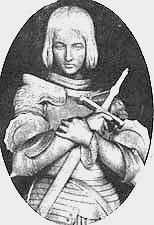"... A Feather on the Breath of God"
Some of the most haunting music I've ever heard can be found on 11,000 Virgins: Chants for the Feast of St. Ursula, music of Hildegard von Bingen by the a cappella group, Anonymous 4. I had earlier appreciated The Origin of Fire: Music and Visions of Hildegard von Bingen and was interested enough to learn more about the mystic medieval religieuse ...
Hildegard von Bingen, born the tenth child in a family of Germanic nobles in the 12th century, was sent to a convent at the age of eight as a tithe to the Church. She was placed in the care of Jutta, the convent's popular Mother Superior and, upon Jutta's death in 1136, was chosen Superior of that community.
From young girlhood, Hildegard claimed to have visions. She was said to have received a prophetic call from God in 1141, demanding of her, "Write what you see." Her initial vision was thought to have given her instant understanding of the meaning of the religious texts and God had commanded her to write down everything she would observe in her visions. Yet Hildegard hesitated to act.
Not an impassioned firebrand like Saint Joan (Hildegard's life and visions, occurring nearly two centuries before Joan of Arc, and widely honored by her contemporaries, are a fascinating counterpoint to the martyred Joan), Hildegard wanted her visions sanctioned by the Catholic Church.
She wrote to St. Bernard of Clairvaux, who brought them to the attention of Pope Eugenius (1145-53). The Pope created a commission which ultimately declared her to be a genuine mystic and not insane. With papal imprimatur, Hildegard was able to finish her first visionary work Scivias ("Know the Ways of the Lord").
Recent scholarly interest in women in the medieval church has led to a popularization of Hildegard -- particularly of her music. Approximately eighty compositions survive, a far larger repertoire than almost any other medieval composer. She also wrote scientific and medical works.
Her vivid description of physical sensations accompanying her visions have been diagnosed by neurologists (including neurologist-author Oliver Sacks) as migraine symptoms; others see in them merely colorful illustrations of prevailing church doctrine, which she supported, rather than actual visions.
Hildegard's writings are also unique for their candid, fairly positive view of sex, and they may include the first description of the female orgasm.
"When a woman is making love with a man, a sense of heat in her brain, which brings with it sensual delight, communicates the taste of that delight during the act and summons forth the emission of the man's seed. And when the seed has fallen into its place, that vehement heat descending from her brain draws the seed to itself and holds it, and soon the woman's sexual organs contract, and all the parts that are ready to open up during the time of menstruation now close, in the same way as a strong man can hold something enclosed in his fist."
With my closed-minded, obviously wrong, misconceptions about the cloistered life, this is quite the -- um -- startling paragraph. But it's lovely, isn't it?
A powerful woman for medieval times, Hildegard communicated with Popes, statesmen, emperors and heads of monasteries, who asked her for prayers and for her opinion on various matters. She traveled widely, giving public speeches, a rarity for a woman of the time.
Her last years were very productive, as she expanded upon her theology of microcosm and macrocosm, with man being the ultimate outcome of God's creation, man as a mirror through which the splendor of God was reflected.
Hildegard was one of the first saints for which the canonization process was officially applied, but she ultimately earned her sainthood as a result of the long-standing devotion of the people, without the formal canonization process, at the end of the sixteenth century. Her feast day is September 17.
source material: wikipedia


7 Comments:
I love her music a lot, have two earlier cds that I listen to in the studio. Thanks for a terrific post.
2:26 PM
I love Hildegard, as you know. Great post!
6:41 PM
We like your articles and find them very interesting. Things we never knew or even thought about. You open our minds.
8:38 PM
awww. thank you.
9:03 PM
Hey M, I'm reading an interesting book, The History of Sexuality by Michael Foulcault.
It might shed some light on this statement here:
'With my closed-minded, obviously wrong, misconceptions about the cloistered life, this is quite the -- um -- startling paragraph.'
According to this book, in medieval times, sexuality was more openly discussed and accepted. In fact, says the great repression started around the 17th century. I found this book in the box in the basement that I found the KHalil Gibran book. I bought it years ago and forgot to read it I guess. Its always interesting to learn something new :-)
Great post. I still have the 'recovering' Catholic's love of saints and all things related to saints.
8:21 AM
You do have the most beautiful posts. Both visually and in the writing.
The name Hildegard will never sound the same to me again.
9:28 AM
Anonymous 4 has the most beautiful music...haunting. A rainy afternoon with my coffee and the Times can't be beat. Thank you for the background information on the Saint Hildegard, your posts always leave me hungry for even more!
11:40 AM
Post a Comment
<< Home